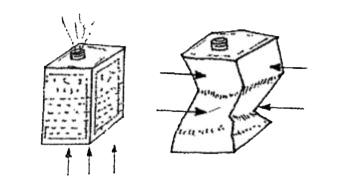Formation of steam from water on boiling is
reversible change
irreversible change
chemical change
undesirable change.
The correct Answer is:A
To determine the type of change that occurs when steam is formed from water upon boiling, we can analyze the process step by step:
1. Understanding the Initial State:
- Water is present in a liquid state before boiling.
Hint: Identify the state of matter before the change occurs.
2. Boiling Process:
- When water is heated to its boiling point, it undergoes a transformation from liquid to gas. This gas is known as steam.
Hint: Consider what happens to the molecules of water when heat is applied.
3. Change Type Analysis:
- The change from liquid water to steam is a physical change, not a chemical change. This is because the chemical composition of water (H₂O) remains the same; only its state changes.
Hint: Remember that a chemical change results in the formation of new substances, while a physical change does not.
4. Reversibility of the Change:
- The steam can be condensed back into water when cooled. This means the change is reversible, as the original substance (water) can be obtained again.
Hint: Think about whether the process can be reversed to get the original substance back.
5. Conclusion:
- Since the change from water to steam can be reversed and does not involve the formation of a new substance, the correct answer is that the formation of steam from water on boiling is a reversible change.
Final Answer:
- The formation of steam from water on boiling is A) reversible change.
- Water is present in a liquid state before boiling.
- When water is heated to its boiling point, it undergoes a transformation from liquid to gas. This gas is known as steam.
- The change from liquid water to steam is a physical change, not a chemical change. This is because the chemical composition of water (H₂O) remains the same; only its state changes.
- The steam can be condensed back into water when cooled. This means the change is reversible, as the original substance (water) can be obtained again.
- Since the change from water to steam can be reversed and does not involve the formation of a new substance, the correct answer is that the formation of steam from water on boiling is a reversible change.
- The formation of steam from water on boiling is A) reversible change.
Similar Questions
Knowledge Check
The formation of ice from water is accompained by
Aabsorption of energy as heat.Btemperature increase.Cdecrease in volume.Dan evolution of heat.Which of the following show an increase in entropy?
I Boiling of water
II Melting of ice
III Freezing of water
IV Formation of hydrogen gas from water.A(I) and (II)BOnly (III)C(I) ,(II) and (IV)D(III) and (IV)Boiling point of water
Ais always 100∘CBcan only be ≤100∘CCcan only be ≥100∘CDcan be <100∘C,=100∘Cor>100∘C
Some water in a tin with a lid which can be tightly screwed on its open mouth. The water is heated to boil and the steam from boiling water is allowed to escape for some time. The open mouth is sealed with air-tight cap and the can is cooled under tap-water. The sides of the can are crushed and get deformed.

View SolutionFind how much heat is necesssary to do internal work in converting 1g of water at the normal boiling point into steam at the same temperature. Latent heat capacity of steam =540×103calkg−1, volume of 1kg of steam at 100∘C=1.65m3
View SolutionBoiling point of water
View SolutionBoiling point of water
View SolutionBurns from steam are worse those from boiling water at the same temperature. Is it true? If so, why?
View Solution
